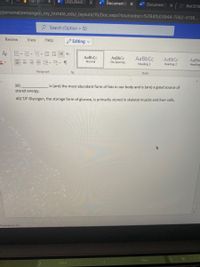
Human Anatomy & Physiology (11th Edition)
11th Edition
ISBN: 9780134580999
Author: Elaine N. Marieb, Katja N. Hoehn
Publisher: PEARSON
expand_more
expand_more
format_list_bulleted
Concept explainers
Question

Transcribed Image Text:Hurry! Ite
Document2
Document2 x
W
W Document2
TO Biol3210
/personal/eenongen_my_tnstate_edu/_layouts/15/Doc.aspx?sourcedoc=%7B4fb03944-7062-4106..
O Search (Option + Q)
Review
View
Help
Editing v
AaBbCc
AaBbCc
No Spacing
AaBbCc
AaBbCc
AaBb
Normal
Heading 1
Heading 2
Heading
Paragraph
Styles
39)
stored energy.
is (are) the most abundant form of fats in our body and is (are) a good source of
40) T/F Glycogen, the storage form of glucose, is primarily stored in skeletal muscle and liver cells.
Predictions: On
You
Hey
Expert Solution
This question has been solved!
Explore an expertly crafted, step-by-step solution for a thorough understanding of key concepts.
Step by stepSolved in 3 steps

Knowledge Booster
Learn more about
Need a deep-dive on the concept behind this application? Look no further. Learn more about this topic, biology and related others by exploring similar questions and additional content below.Similar questions
- Explain what are the major advantages of using triacylglycerols (fats) for energy storage over glycogen or starch (both are sugar storage polymers).arrow_forwardTRUE OR FALSE: Please answer each item. Hormones, such as testosterone, estradiol and progesterone are examples of steroidal lipids synthesized from cholesterol, which serve as precursor. Chain Shortening of monosaccharides can be done in the laboratory thru Kiliani-Fischer reaction. Glycerophospholipids are the most abundant lipids in cellular membranes and are also involved in metabolism and signaling In delta notation of fatty acid nomenclature, the numbering starts at the α-carbon from the carboxylic acid end. Chain elongation of monosaccharides can be done in the laboratory thru Ruff reaction.arrow_forwardwhy long distance runner should intake less oily food (trans fat) briefly explain whyarrow_forward
- Certain low-carb, high-protein diets call for eating large amounts of protein hydrolysate. This strategy can be dangerous, because while body weight can drop quickly, this is largely due to water loss, rather than fatty acid oxidation. Why might this diet approach end up with so much water being lost?arrow_forwardfill in the blanks Glycogen is built from the protein scaffold ( ) with glucose forming a glycosidic bond with the amino acid ( ).arrow_forwardWould substituting fiber and complex carbohydrates (larger % cellulose) for the simple sugars and starches (high sucrose and amylose/amylopectin) help Morgan lose weight, why? Yes, because complex carbohydrates like cellulose are largely indigestible so they pass through the digestive tract without being absorbed. Yes, cellulose contains less glucose residues than amylose or amylopectin. Yes, because the fructose in sucrose is much more responsible for weight gain than the glucose. No, because cellulose, amylose, and amylopectin are all composed of glucose so it doesn’t matter.arrow_forward
- Briefly explain why chicken fat, which largely consists of various triacylglycerols, has such a higher energy content per mole compared to sucrose.arrow_forwardLipids are highly oxidized molecules, so they can be greatly reduced for energy during catabolism (degradation). True Or Falsearrow_forwardBack in the 1930s, a chemical called DNP (2,4-Dinitrophenol) was prescribed as a weight loss pill. Describe how DNP is a metabolic poison , and why it was thought to be a good mechanism for weight loss?arrow_forward
- Where [tissue(s)] is glycogen stored in large amounts in the body? Which tissue type contains the majority of the body’s glycogen?arrow_forwardWhat is/are the specific difference(s) between glucose and galactose? What is/are the specific difference(s) between glucose and fructose?arrow_forwardUsing the image provided, answer the two questions:- Based on their fat content, which is the healthier option? Explain your answer.- Based on all of the nutritional information, which do you think is the healthier option? Explain your answer.arrow_forward
arrow_back_ios
SEE MORE QUESTIONS
arrow_forward_ios
Recommended textbooks for you
 Human Anatomy & Physiology (11th Edition)BiologyISBN:9780134580999Author:Elaine N. Marieb, Katja N. HoehnPublisher:PEARSON
Human Anatomy & Physiology (11th Edition)BiologyISBN:9780134580999Author:Elaine N. Marieb, Katja N. HoehnPublisher:PEARSON Biology 2eBiologyISBN:9781947172517Author:Matthew Douglas, Jung Choi, Mary Ann ClarkPublisher:OpenStax
Biology 2eBiologyISBN:9781947172517Author:Matthew Douglas, Jung Choi, Mary Ann ClarkPublisher:OpenStax Anatomy & PhysiologyBiologyISBN:9781259398629Author:McKinley, Michael P., O'loughlin, Valerie Dean, Bidle, Theresa StouterPublisher:Mcgraw Hill Education,
Anatomy & PhysiologyBiologyISBN:9781259398629Author:McKinley, Michael P., O'loughlin, Valerie Dean, Bidle, Theresa StouterPublisher:Mcgraw Hill Education, Molecular Biology of the Cell (Sixth Edition)BiologyISBN:9780815344322Author:Bruce Alberts, Alexander D. Johnson, Julian Lewis, David Morgan, Martin Raff, Keith Roberts, Peter WalterPublisher:W. W. Norton & Company
Molecular Biology of the Cell (Sixth Edition)BiologyISBN:9780815344322Author:Bruce Alberts, Alexander D. Johnson, Julian Lewis, David Morgan, Martin Raff, Keith Roberts, Peter WalterPublisher:W. W. Norton & Company Laboratory Manual For Human Anatomy & PhysiologyBiologyISBN:9781260159363Author:Martin, Terry R., Prentice-craver, CynthiaPublisher:McGraw-Hill Publishing Co.
Laboratory Manual For Human Anatomy & PhysiologyBiologyISBN:9781260159363Author:Martin, Terry R., Prentice-craver, CynthiaPublisher:McGraw-Hill Publishing Co. Inquiry Into Life (16th Edition)BiologyISBN:9781260231700Author:Sylvia S. Mader, Michael WindelspechtPublisher:McGraw Hill Education
Inquiry Into Life (16th Edition)BiologyISBN:9781260231700Author:Sylvia S. Mader, Michael WindelspechtPublisher:McGraw Hill Education

Human Anatomy & Physiology (11th Edition)
Biology
ISBN:9780134580999
Author:Elaine N. Marieb, Katja N. Hoehn
Publisher:PEARSON

Biology 2e
Biology
ISBN:9781947172517
Author:Matthew Douglas, Jung Choi, Mary Ann Clark
Publisher:OpenStax

Anatomy & Physiology
Biology
ISBN:9781259398629
Author:McKinley, Michael P., O'loughlin, Valerie Dean, Bidle, Theresa Stouter
Publisher:Mcgraw Hill Education,

Molecular Biology of the Cell (Sixth Edition)
Biology
ISBN:9780815344322
Author:Bruce Alberts, Alexander D. Johnson, Julian Lewis, David Morgan, Martin Raff, Keith Roberts, Peter Walter
Publisher:W. W. Norton & Company

Laboratory Manual For Human Anatomy & Physiology
Biology
ISBN:9781260159363
Author:Martin, Terry R., Prentice-craver, Cynthia
Publisher:McGraw-Hill Publishing Co.

Inquiry Into Life (16th Edition)
Biology
ISBN:9781260231700
Author:Sylvia S. Mader, Michael Windelspecht
Publisher:McGraw Hill Education